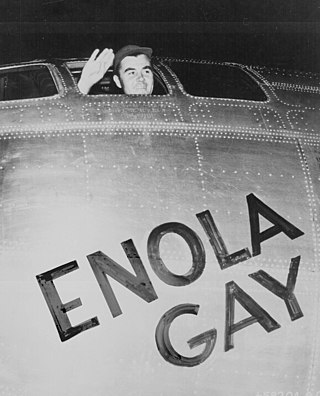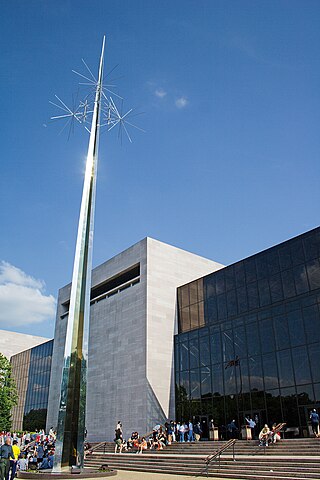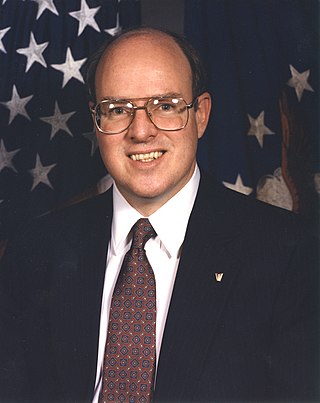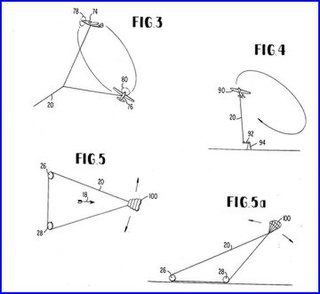
The Enola Gay is a Boeing B-29 Superfortress bomber, named after Enola Gay Tibbets, the mother of the pilot, Colonel Paul Tibbets. On 6 August 1945, during the final stages of World War II, it became the first aircraft to drop an atomic bomb in warfare. The bomb, code-named "Little Boy", was targeted at the city of Hiroshima, Japan, and caused the destruction of about three quarters of the city. Enola Gay participated in the second nuclear attack as the weather reconnaissance aircraft for the primary target of Kokura. Clouds and drifting smoke resulted in Nagasaki, a secondary target, being bombed instead.

The National Air and Space Museum of the Smithsonian Institution, is a museum in Washington, D.C., in the United States dedicated to human flight and space exploration.
The Lockheed Model 10 Electra is an American twin-engined, all-metal monoplane airliner developed by the Lockheed Aircraft Corporation in the 1930s to compete with the Boeing 247 and Douglas DC-2. The type gained considerable fame as one was flown by Amelia Earhart on her ill-fated around-the-world expedition in 1937.

The Kyūshū J7W Shinden was a World War II Japanese propeller-driven prototype fighter with wings at the rear of the fuselage, a nose-mounted canard, and pusher engine.

The Steven F. Udvar-Hazy Center, also called the Udvar-Hazy Center, is the Smithsonian National Air and Space Museum (NASM)'s annex at Washington Dulles International Airport in the Chantilly area of Fairfax County, Virginia. It holds numerous exhibits, including the Space Shuttle Discovery, the Enola Gay, and the Boeing 367-80, the main prototype for the popular Boeing 707 airliner.

The Nakajima J1N1 Gekkō is a twin-engine aircraft used by the Japanese Imperial Navy during World War II and was used for reconnaissance, night fighter, and kamikaze missions. The first flight took place in May 1941. It was given the Allied reporting name "Irving", since the earlier reconnaissance version the J1N1-C, was mistaken for a fighter.

Alfred Melville Pride was a United States Navy admiral and pioneer naval aviator, who distinguished himself during World War II as an aircraft carrier commander.

The Northrop XP-56 Black Bullet was a unique prototype fighter interceptor built by the Northrop Corporation. It was one of the most radical of the experimental aircraft built during World War II. Ultimately, it was unsuccessful and did not enter production.

The North American O-47 is an American observation fixed-wing aircraft monoplane designed in the mid-1930s and used by the United States Army Air Corps during the Second World War. It has a low-wing configuration, retractable landing gear, and a three-blade propeller.
Operation LUSTY was the United States Army Air Forces' effort to capture and evaluate German aeronautical technology during and after World War II.

The Langley Aerodrome was a pioneering but unsuccessful manned, tandem wing-configuration powered flying machine, designed at the close of the 19th century by Smithsonian Institution Secretary Samuel Langley. The U.S. Army paid $50,000 for the project in 1898 after Langley's successful flights with small-scale unmanned models two years earlier.

The Swoose is a B-17D-BO Flying Fortress, USAAF Ser. No. "40-3097", that saw extensive use in the Southwest Pacific theatre of World War II and survived to become the oldest B-17 still intact. It is the only early "shark fin" B-17 known to exist, and the only surviving B-17 to have seen action in the 1941–42 Philippines Campaign, operating on the first day of the United States entry into the war.

The Culver PQ-14 Cadet is a modified version of the Culver LFA Cadet used as a target drone.

The Paul E. Garber Preservation, Restoration, and Storage Facility, also known colloquially as "Silver Hill", is a storage and former conservation and restoration facility of the Smithsonian National Air and Space Museum, located in Suitland, Maryland, United States. Located adjacent to the Museum Support Center – a facility that serves the same purpose for other Smithsonian museums – the Paul E. Garber Facility was once the main artifact restoration facility of the National Air and Space Museum. The museum still stores aircraft and other artifacts at the Paul E. Garber Facility, but most storage and restoration functions have relocated to the Mary Baker Engen Restoration Hangar at the Steven F. Udvar-Hazy Center in Chantilly, Virginia. The facility is not open to the public.

Richard P. Hallion is Senior Adviser for Air and Space Issues, Directorate for Security, Counterintelligence and Special Programs Oversight, the Pentagon, Washington, D.C. He is responsible for analysis and insight regarding the conceptualization, evolution and utilization of sensitive national technological programs and related subject areas.
The Blossom Kite Festival, formerly the Smithsonian Kite Festival, is an annual kite event usually held on the National Mall in Washington, D.C. in late March during the National Cherry Blossom Festival. The event's organizers cancelled all kite festivals since 2020 because of concerns related to the ongoing coronavirus pandemic.

The Bell Model 65 Air Test Vehicle (ATV) was an experimental tiltjet VTOL aircraft built by Bell using parts from a number of general aviation aircraft.

Smithsonian Libraries and Archives is an institutional archives and library system comprising 21 branch libraries serving the various Smithsonian Institution museums and research centers. The Libraries and Archives serve Smithsonian Institution staff as well as the scholarly community and general public with information and reference support. Its collections number nearly 3 million volumes including 50,000 rare books and manuscripts.

Walter J. Boyne was a United States Air Force officer, Command Pilot, combat veteran, aviation historian, and author of more than 50 books and over 1,000 magazine articles. He was a director of the National Air and Space Museum of the Smithsonian Institution and a Chairman of the National Aeronautic Association.

Crosswind kite power is power derived from airborne wind-energy conversion systems or crosswind kite power systems (CWKPS). The kite system is characterized by energy-harvesting parts flying transverse to the direction of the ambient wind, i.e., to crosswind mode; sometimes the entire wing set and tether set is flown in crosswind mode. From toy to power-grid-feeding sizes, these systems may be used as high-altitude wind power (HAWP) devices or low-altitude wind power (LAWP) devices without having to use towers. Flexible wings or rigid wings may be used in the kite system. A tethered wing, flying in crosswind at many times wind speed, harvests wind power from an area that exceeds the wing's total area by many times.

















